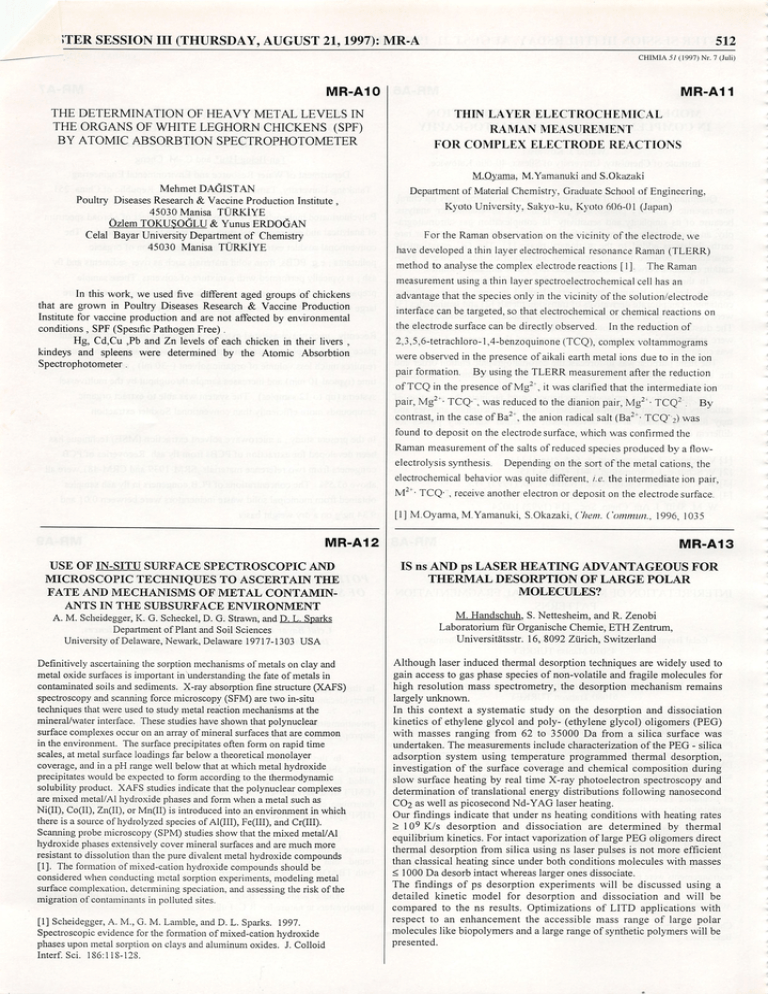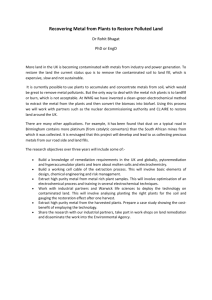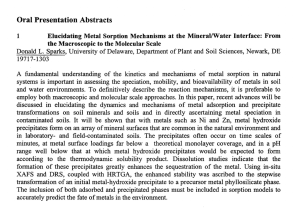.TER SESSION III (THURSDAY, AUGUST ...
advertisement

.TER SESSION III (THURSDAY, AUGUST 21,1997): MR-A 512 CHIMIA5/(I997) Nr. 7 (Juli) M R - A 1 0 MR-A11 T H E D E T E R M I N AT I O N O F H E AV Y M E TA L L E V E L S I N THIN THE ORGANS OF WHITE LEGHORN CHICKENS (SPF) B Y AT O M I C A B S O R B T I O N S P E C T R O P H O T O M E T E R L AY E R RAMAN ELECTROCHEMICAL MEASUREMENT FOR COMPLEX ELECTRODE REACTIONS M.Qyama, M.Yamanuki and S.Ok;izaki M e h m e t D A G I S TA N Poultry Diseases Research & Vaccine Production Institute , Department of Material Chemistry, Graduate School of Engineering, Kyoto University, Sakyo-ku, Kyoto 606-01 (Japan) 45030 Manisa TURKlYE Ozlem TOKUSOGLU & Yunus ERDOGAN For the Raman observation on the vicinity of the electrode, we Ceial Bayar University Department of Chemistry 45030 Manisa TORKIYE have developed a thin layer electrochemical resonance Raman (TLERR) method to analyse the complex electrode reactions [1], The Raman measurement using a thin layer spectroelectrochemical cell has an In this work, we used five different aged groups of chickens that are grown in Poultry Diseases Research & Vaccine Production Institute for vaccine production and are not affected by environmental conditions , SPF (Spesific Pathogen Free). Hg, Cd,Cu ,Pb and Zn levels of each chicken in their livers , kindeys and spleens were determined by the Atomic Absorbtion Spectrophotometer . advantage that the species only in the vicinity of the solution/electrode interface can be targeted, so that electrochemical or chemical reactions on the electrode surface can be directly observed. In the reduction of 2,3,5,6-tetrachIoro-l,4-benzoquinone (TCQ), complex voltammograms were observed in the presence of aikali earth metal ions due to in the ion pair formation. By using the TLERR measurement after the reduction of TCQ in the presence of Mg"', it was clarified that the intermediate ion pair, Mg^'- TCQ-, was reduced to the dianion pair, Mg^'- TCQ" . By contrast, in the case of Ba^', the anion radical salt (Ba^"' TCQ" 2) was found to deposit on the electrode surface, which was confirmed the Raman measurement of the salts of reduced species produced by a flowelectrolysis synthesis. Depending on the sort of the metal cations, the electrochemical behavior was quite different, i.e. the intermediate ion pair, M^'- TCQ' , receive another electron or deposit on the electrode surface. [1] M.Oyama, M.Yamanuki, S.Okazaki, fV;;;/)?. Commiin., 1996, 1035 M R - A 1 2 M R - A 1 3 U S E O F I N - S I T U S U R FA C E S P E C T R O S C O P I C A N D IS ns AND ps LASER HEATING ADVANTAGEOUS FOR MICROSCOPIC TECHNIQUES TO ASCERTAIN THE THERMAL DESORPTION OF LARGE POLAR FAT E A N D M E C H A N I S M S O F M E TA L C O N TA M I N MOLECULES? A N T S I N T H E S U B S U R FA C E E N V I R O N M E N T M. Handschuh. S. Nettesheim, and R. Zenobi Laboratorium fur Organische Chemie, ETH Zentrum, A. M. Scheidegger, K. G. Scheckel, D. G. Strawn, and P. L. Sparks Department of Plant and Soil Sciences University of Delaware, Newark, Delaware 19717-1303 USA Definitively ascertaining the sorption mechanisms of metals on clay and metal oxide surfaces is important in understanding the fate of metals in contaminated soils and sediments. X-ray absorption fine structure (XAFS) spectroscopy and scanning force microscopy (SFM) are two in-situ teclmiques that were used to study metal reaction mechanisms at the mineral/waler interface. These studies have shown that polynuclear Universitatsstr. 16, 8092 Zurich, Switzerland Although laser induced thermal desorption techniques are widely used to gain access to gas phase species of non-volatile and fragile molecules for high resolution mass spectrometry, the desorption mechanism remains largely unknown. In this context a systematic study on the desorption and dissociation kinetics of ethylene glycol and poly- (ethylene glycol) oligomers (PEG) surface complexes occur on an array of mineral surfaces that are common in the environment. The surface precipitates often form on rapid time with masses ranging from 62 to 35000 Da from a silica surface was scales, at metal surface loadings far below a theoretical monolayer adsorption system using temperature programmed thermal desorption, investigation of the surface coverage and chemical composition during slow surface heating by real time X-ray photoelectron spectroscopy and coverage, and in a pH range well below that at which metal hydroxide precipitates would be expected to form according to the thermodynamic solubility product. XAFS studies indicate that the polynuclear complexes are mixed metal/Al hydroxide phases and form when a metal such as Ni(II), Co(II), Zn(II), or Mn(H) is introduced into an environment in which there is a source of hydrolyzed species of Al(III), Fe(III), and Cr(III). Scanning probe microscopy (SPM) studies show that the mixed metal/Al hydroxide phases extensively cover mineral surfaces and are much more resistant to dissolution than the pure divalent metal hydroxide compounds [1]. The formation of mixed-cation hydroxide compounds should be considered when conducting metal sorption experiments, modeling metal surface complexation, determining speciation, and assessing the risk of the migration of contaminants in polluted sites. undertaken. The measurements include characterization of the PEG - silica determination of translational energy distributions following nanosecond CO2 as well as picosecond Nd-YAG laser heating. Our findings indicate that under ns heating conditions with heating rates > 10' K/s desorption and dissociation are determined by thermal equilibrium kinetics. For intact vaporization of large PEG oligomers direct thermal desorption from silica using ns laser pulses is not more efficient than classical heating since under both conditions molecules with masses < 1000 Da desorb intact whereas larger ones dissociate. The findings of ps desorption experiments will be discussed using a detailed kinetic model for desorption and dissociation and will be compared to the ns results. Optimizations of LITD applications with [1] Scheidegger, A. M., G. M. Lamble, and D. L. Sparks. 1997. Spectroscopic evidence for the formation of mixed-cation hydroxide respect to an enhancement the accessible mass range of large polar molecules like biopolymers and a large range of synthetic polymers will be phases upon metal sorption on clays and aluminum oxides. J. Colloid presented. I n t e r f S c i . 1 8 6 : 11 8 - 1 2 8 ,








